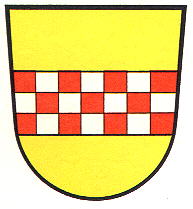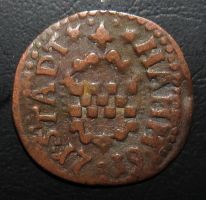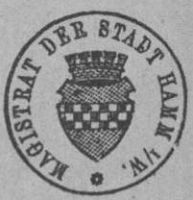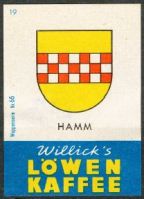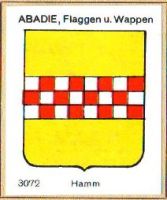Hamm: Difference between revisions
Knorrepoes (talk | contribs) |
Knorrepoes (talk | contribs) No edit summary |
||
| Line 12: | Line 12: | ||
|- | |- | ||
|'''German''' | |'''German''' | ||
| | | In Gold einen in drei Reihen zu je sieben Feldern rot und silbern geschachten Balken. | ||
|- | |- | ||
|'''English''' | |'''English''' | ||
| | | Or a fess chequy Gules and Argent of three. | ||
|} | |} | ||
===Origin/meaning=== | ===Origin/meaning=== | ||
Hamm was founded in 1226 by Adolf I, Count of the Mark, and later became the capital of the [[County of Mark]]. In 1263 the village received city rights and from the same time dates the oldest seal. This seal shows a castle on a hill, on which the lion of the arms of the Counts of the Mark is placed. Around 1275 the arms of the Counts was changed to the chequered bar. The city subsequently started to use the new arms in its seals since 1297. The new arms became known as the 'small arms' of the city until 1875, when it became the official arms. The arms were reconfirmed in 1909 and 1934. | Hamm was founded in 1226 by Adolf I, Count of the Mark, and later became the capital of the [[County of Mark]]. In 1263 the village received city rights and from the same time dates the oldest seal. This seal shows a castle on a hill, on which the lion of the arms of the Counts of the Mark is placed. Around 1275 the arms of the Counts was changed to the chequered bar. The city subsequently started to use the new arms in its seals since 1297. The new arms became known as the 'small arms' of the city until 1875, when it became the official arms. The arms were reconfirmed in 1909 and 1934. | ||
Revision as of 05:12, 16 July 2022
This page is part of the German heraldry portal Deutsche Wappensammlung |
Heraldry of the World |
|
German heraldry:
|
Selected collector's items from Germany:
|
HAMM
State : Nordrhein-Westfalen
Urban District (Kreisfreie Stadt) : Hamm
Additions : 1939 Mark; 1968 Berge, Westtünen, Wiescherhöfen; 1974 Bockum-Hövel (1934, Bockum, Hövel), Heessen, Pelkum (1968 Herringen, Lerche, Sandbochum, Weetfeld), Rhynern (1968 Amt Rhynern (partly), Allen, Freiske, Hilbeck (1975 to Werl), Osterflierich, Osttünnen, Süddinker, Wambeln), Uentrop (1968 Braam-Ostwennemar (partly), Frielinghausen, Haaren, Norddinker, Schmehausen, Vöckinghausen, Werries)
| German | In Gold einen in drei Reihen zu je sieben Feldern rot und silbern geschachten Balken. |
| English | Or a fess chequy Gules and Argent of three. |
Origin/meaning
Hamm was founded in 1226 by Adolf I, Count of the Mark, and later became the capital of the County of Mark. In 1263 the village received city rights and from the same time dates the oldest seal. This seal shows a castle on a hill, on which the lion of the arms of the Counts of the Mark is placed. Around 1275 the arms of the Counts was changed to the chequered bar. The city subsequently started to use the new arms in its seals since 1297. The new arms became known as the 'small arms' of the city until 1875, when it became the official arms. The arms were reconfirmed in 1909 and 1934.
Between 1297 and 1875 the city also used the 'large arms', which were a combination of the old castle and lion on the left half of the shield and the bar in the right half.
The arms in the Wappen-Sammlung (1900)
The arms by Hupp in the Kaffee Hag albums +/- 1925
The arms in the Emmerlinge album
The arms in the Abadie albums
Contact and Support
Partners:
Your logo here ?
Contact us
© since 1995, Heraldry of the World, Ralf Hartemink 
Index of the site
Literature : Stadler, 1964-1971, 8 volumes.


